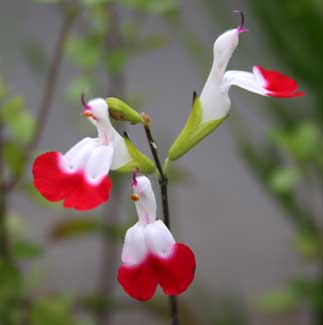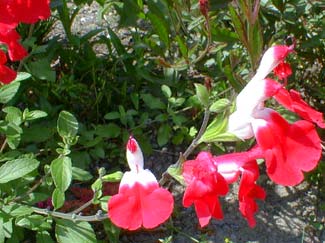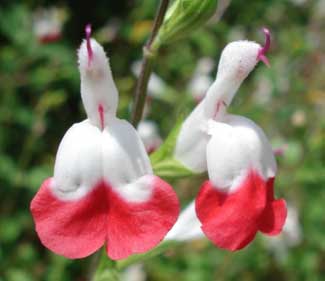 | |
"What distillate can be discovered from herbs of a witching brew," said an aesthete, "what distillate prepared according to the formulas of ancient Grecosyrian magi which for a day (if no longer its potency can last), or even for a short time can bring my twenty three years to me again; can bring my friend of twenty two to me again -- his beauty, his love. "What distillate prepared according to the formulas of ancient Grecosyrian magi which, in bringing back these things, can also bring back our little room." -"According To | |
'Hot Lips' Sage
'Hot Lips' is a variety of sage released by Strybing Arboretum in 2002, reaching the Seattle area market by late winter 2003.
Granny Artemis & I just happened to be on the look-out for further shrub-sages that might make it in our temperate zone when at the Rhododendron Species Foundation spring sale we encountered a chap whose little company "Smarty Plants" from Edmonds, Washington, was displaying a score of varieties of sages, from alpine hardies to fully tropical species, all with good photos of what the blooms were like since it was too early to display his plants in bloom.
We wouldn't know, until experience & hindsight, that we had stumbled on a variety that a few short years later would be very much a standard cultivar for Northwest gardens, very easily accessible, but at that Foundation sale, it was something scarsely anyone had seen before.
Unfortunately the more dramatic & extravagant sage flowers are for species that are the least likely to be garden-hardy for a temperate zone. The more garden-hardy they get for our zone, the more humble the blooms.
We don't have a greenhouse or an indoor herbarium, so we are always watching for the "exceptions" that might adapt to our weather patterns as more than annuals-by-default. Smarty Plants has so many wonderful varieties & provided full information on each. The majority of the fancier ones, alas, were not the least bit winter hardy.
But 'Hot Lips' had been developed in that San Francisco arboretum, & weather on San Francisco Bay really isn't all that different from on Puget Sound. Though it promised only to be hardy to 20 degrees F., 'Hot Lips' seemed definitely worth the risk for our sun garden.
Only time would tell if it was going to be a permanent resident for us. It made it through its first winter without any trouble at all, despite that we had a record-breaking coldsnap, so I knew it was here to stay. It didn't mind temperatures into the high 'teens, & it didn't mind our rainy autumns. The perfect shrub-sage for our area!
 It has bicolor flowers, white with red lips. Actually, the flowers are often quite different bloom to bloom even on a single branch. A few are entirely white, a few more are completley red, the majority about evenly divided half-white & half-red.
It has bicolor flowers, white with red lips. Actually, the flowers are often quite different bloom to bloom even on a single branch. A few are entirely white, a few more are completley red, the majority about evenly divided half-white & half-red.The sprinkling of all-white or all-red blooms, among the majority bicolored, does not mean it is reverting to "normal" even on one branch; every branch merely is that unstable in color expression, but with a decided preference for the largest number of bicolor flowers.
The manner by which this plant reached cultivation is a story in itself. Richard Turner, editor of Pacific Horticulture Magazine, threw a house warming party, for which his Mexican maid Alta-Gracia provided flowers from her personal garden, including a certain salvia from Oaxaca, Mexico, which none of Alta-Gracia's boss's horticultural buddies had ever seen before. Overlooking for the moment the abominable cliche of rich honkies with their Latina servants, we may count it lucky her name is reported at all, even without last name.
In any event, Turner & his buddies were volunteers at the Strybing Arboretum, & it was the volunteers who went to work preserving Alta-Gracia's Oaxaca bouquet cuttings, hence voila!, a new variety came into the nursery trade.
It blooms beginning May, is in richest bloom all summer, & will keep flowering deep into autumn. It's first year in our sun-garden, it increased in flowering through October. The second year it was fantastically flowery by May, & still had a few flowers on it in at November's end when finally the increasing chill stopped it. In December I trimmed back the dying branches. We'd eventually plant a second one & they are so long-flowering & reliably beautiful that I took to recommending it to everyone I know who gardens.
 I had expected it to behave identical to another S. microphylla cultivar in our sun-garden, 'Maraschino' Cherry Sage. But it outperformed even the hardy 'Maraschino.'
I had expected it to behave identical to another S. microphylla cultivar in our sun-garden, 'Maraschino' Cherry Sage. But it outperformed even the hardy 'Maraschino.'In winter, the leaves of 'Hot Lips' turn a dark wine-red. When it finally ceases flowering as the weather gets too cold to bloom, it can retain a percentage of its leaves right up to early spring. However, by winter's end, shrub sages in general in our zone begin to look tawdry & frost-damaged, & 'Hot Lips' in particular is semi-deciduous at best. If not cut back by February or March, shrub sages look increasingly awful the rest of spring, so really must be given a hard pruning in late winter so that they can start the spring all fresh.
Since our first 'Hot Lips' has tended to lean out onto the sidewalk to reach maximum sunlight, I usually cut back the lingering bits earlier in winter or whenever it stops flowering. It returns from a hard pruning with ease. If not hard pruned, it will have fewer flowers the following summer.
Growth rate is so rapid I sometimes have to hard-prune one side of it -- the side that hangs onto the walkway -- & if this is done any time up to September, I end up with an enormous bouquet of redolent leaves & bright-bright flowers superb for indoors.
In our zone 'Hot Lips' really must have full sun, & sharp drainage is likewise a must. In much hotter zones it might tolerate a bit of shade. It is drought tolerant, & is one of the liveliest plants in our roadside sun-garden, getting ahead of many summer bloomers. It grows upright to three feet high & as wide, with small finely textured leaves on dark twigs that greatly set off the brilliant blooms.
As a kitchen herb, it's rather bitter, but with excellent scent. It's not generally regarded as a culinary sage but young fresh leaves crushed & sprinkled lightly into a salad lend it its wonderful scent.
first photo is copyright © by Chet Braun